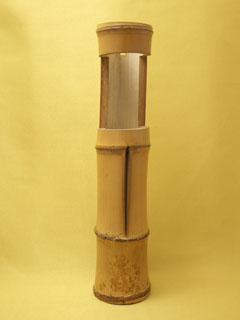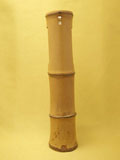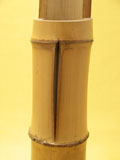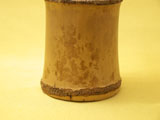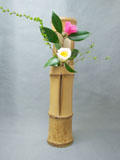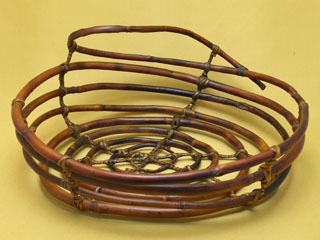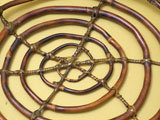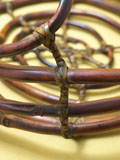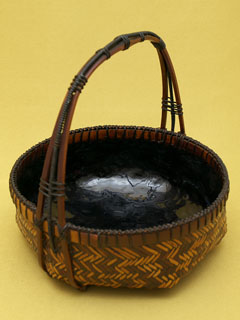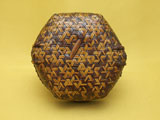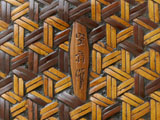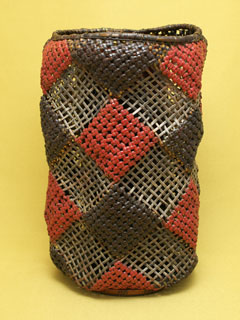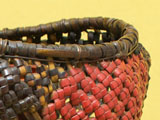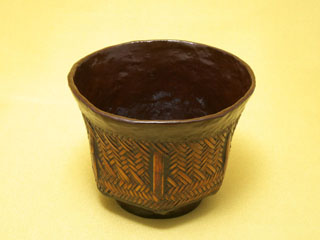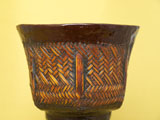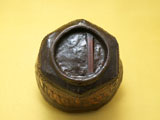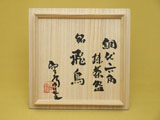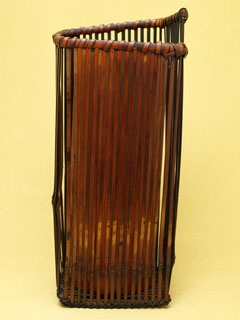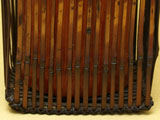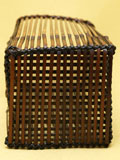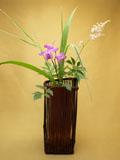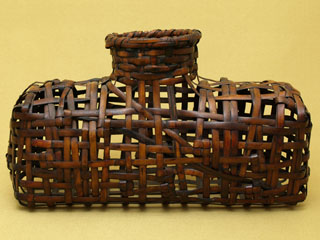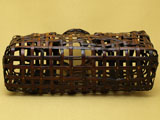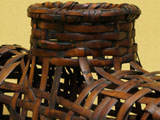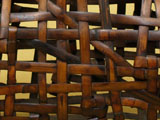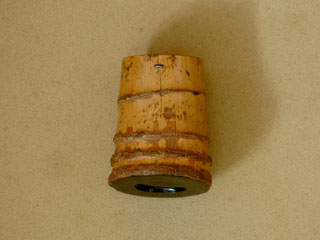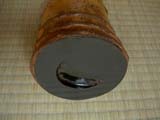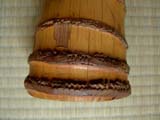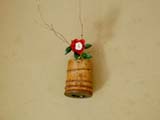空齋竹工芸
蛤谷空齋がこれまでに制作した、竹工芸作品の紹介です。
一重切花入 [66-005]
2008 年 3 月 31 日
煤竹 盛籠 [55-020]
2008 年 2 月 5 日
- 縦31cm×横34cm×高さ16cm
根曲がり竹の煤竹を使用した珍しい作品である。長い竹をそのまま、底の中心から渦巻き状に巻き、途中で竹を継ぎ足しながら、4本の竹で全体の形を作成している。竹と竹との繋ぎにあたっては、竹づくりをして細く薄くした根曲がり竹を、巻きながら留めている。フラワーアレンジメントの盛り花を入れても面白いかもしれない。
Basket for multiple use [55-020]
This basket was made of sooted Nemagaridake. It has spiral plaiting base and formed of four native long bamboo with joinning them. Joints was attached by reeling splitted Nemagaridake. How about using this basket for the flower arrangement?
煤竹網代 手付菓子器 [40-005]
2008 年 1 月 20 日
- 高さ17.5cm×幅16cm×奥行16cm(籠部は高さ6.5cm)
煤竹の特徴である濃淡の美しさを取り入れた作品である。内側には黒漆が何層にも施されている。底は二本取りの鉄線編みで、立ち上がりから胴部分は網代編みである。口造りは、幅10mm程の煤竹を輪にして内側と外側にあてがい、さらに皮籐で細かく巻いている。手の部分には細い煤竹を3本使用し、2本を底へ、1本を側面へ差し込んでいる。そして持ち手となる場所で3本をまとめ、その上から皮籐で細かく巻き、強度と装飾の役目を果たしている。
Basket for Sweets [40-005]
- H.17.5cm(6.9″) x W.16cm(6.3″) x D.16cm
This basket for sweets brings out the best beauty of light and shade of Susudake. A lot of layers of lacquer were applied inside the basket. It has double Tessen plaiting base and twill plaiting body. At the rim, it was touched about 10mm(0.39″) Susudake and stitched finely with split rattan lines. Three lines of Susudake make a handgrip. Two lines of them are joined to body and one of them are joined to base. In order to play an important role in strength and display as an ornament, the handgrip was stitched finely with split rattan lines.
置花入 [55-019]
2008 年 1 月 13 日
- 口径14cmと17cmで歪な形 高さ29.5cm 胴回55cmと57cm
作品全体に根曲竹を使用している。底より麻の葉編みで編み始め、立ち上がりより胴を石畳編みと四つ目編みで編み進めている。胴部分では、2種類の編み方を交互に組み合わせることで、独特な凹凸形状になっている。さらに石畳編みの部分には黒漆と朱漆を、四つ目編みの部分には漆の上に銀粉を施し、燻し銀の風合いに仕上げた。口造りでは、外側と内側から挟むように竹をあてがい、細い竹で巻きながら留め、その上から仕上げとして皮籐による飾り結びを施している。また径14cmで幅12~3mm程の煤竹を、ささらをあてがいつつ皮籐で細かく巻きながら、高台として取り付けている。茶道具制作から離れた、いわば独立したオブジェとしての要素が強く、作者の遊び心が感じられる作品である。
Flower Basket [55-019]
- H.29.5cm(11.6″) x W.14cm(5.5″) x D.17cm(6.7″)
This flower basket was made of Nemagaridake. The basket has a hemp leaf pattern plaiting base and a combination body of square and Ishidatami plaiting. The body has an unique uneven surface since it was made with two kinds of different plaiting techniques. The surface of basket feels like an oxidized silver because it was applied silver dust to Ishidatami plaiting and applied black or red lacquer to square plaiting. At the rim, it was touched bamboo, stitched finely with split bamboo, and decorated with split rattan lines. At the foot, it was made of Susudake and attached by stitching with split rattan lines. This work is an isolated art from tea-things, and it was made with Kusai’s humor.
網代 六角抹茶椀 [20-004]
2007 年 12 月 17 日
- 銘「飛鳥」
煤竹を使用し、網代編みで制作された抹茶椀である。全体が六面で形成され、角に当たる部分には幅10mm程の煤竹が添えられている。内側には、錆朱がかった漆が何層にも施されている。奈良・法隆寺にある夢殿が八角であり、そのイメージから銘が付けられた。
Ajiro Rokkaku Chawan [20-004]
The inscription is “Aska”.
This Chawan was made of Susudake and used twill plaiting.
It has hexagonal shape and it was attached depth 10mm(0.39″) of Susudake to each corner.
A lot of layers of lacquer with rust were applied inside the Chawan.
It was named “Aska” from Yumedono, which had octagon shape, located at Horyu-ji. Horyu-ji is a Buddhist temple in Ikaruga, Nara Prefecture, Japan. This area is also called “Aska”.
| Dimension | H.- x W.- x D.- |
煤竹櫛目編 置花籠 [55-018]
2007 年 8 月 19 日
掛花籠 [60-004]
2007 年 6 月 9 日
竹花入 [66-004]
2007 年 6 月 8 日
